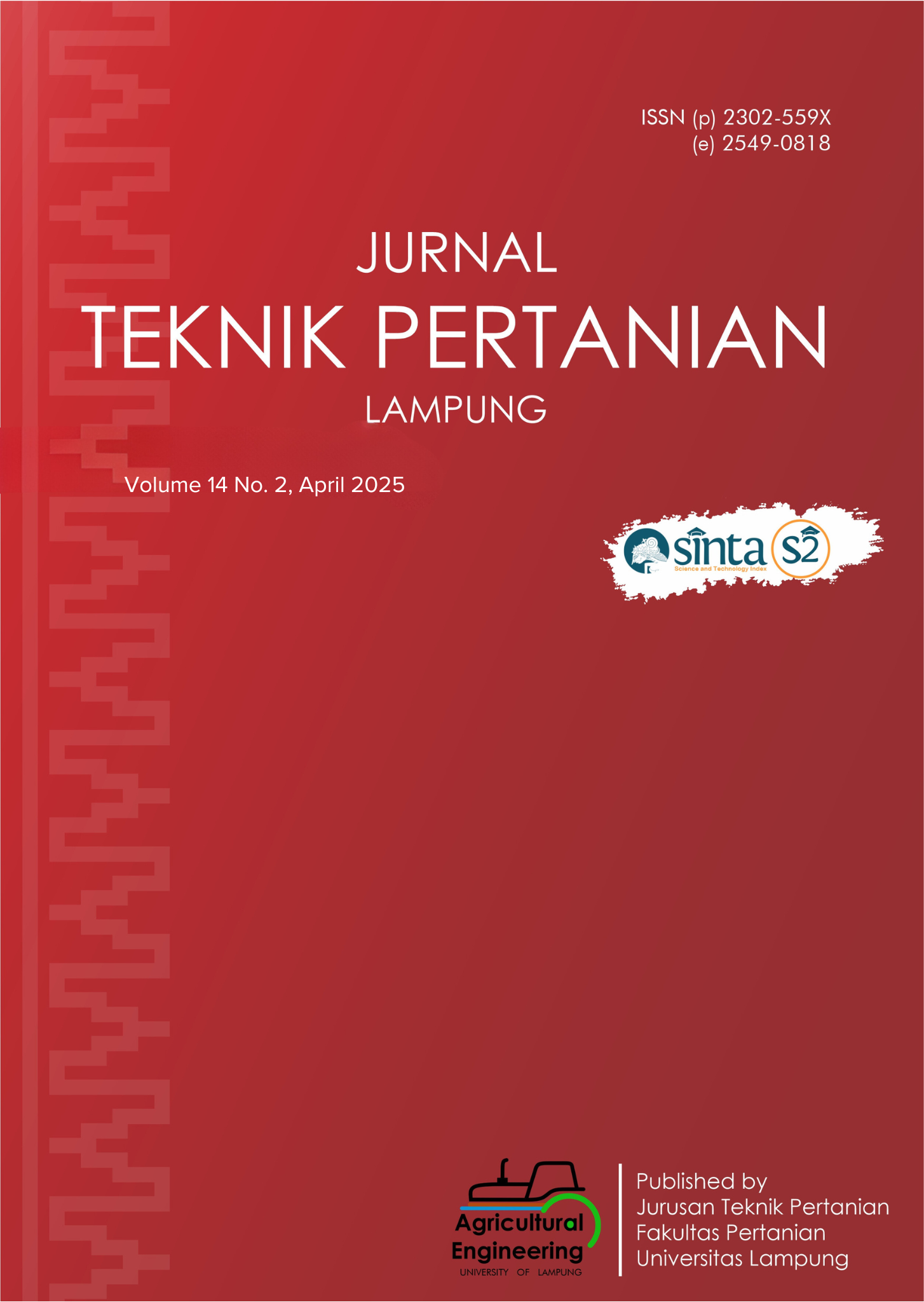Analysis Rice Field Drought Potential using the Standardized Precipitation Index (SPI) Method
DOI:
https://doi.org/10.23960/jtep-l.v14i2.494-505 Abstract View: 184
Abstract View: 184
Abstract
Drought analysis can be used as an early warning of drought in rice fields, which can be identified by connecting various parameters. This study aims to identify the potential for rice fields vulnerable to drought in Agam Regency. Drought is primarily caused by uneven rainfall distribution, leading to imbalanced hydrological conditions. This study used the last 30 years of rainfall data (1993 2022) from five stations located at Agam Regency (Canduang and Gumarang) and the rest outside of the study area (Padang Panjang, Suliki, and Paraman Talang). Spatial analysis of drought distribution was carried out using the Inverse Distance Weighted (IDW) method. The results showed the consistency test value of rainfall data for all five stations was obtained with an average of R² with a value of 0.992, the potential area of rice fields with a dry and very dry category was 13,640.61 ha and 904.55 ha, respectively. The conclusions of this study are (i) the districts with the most potential to be affected by drought (dry and very dry categories) are Tilatang Kamang and Malalak District, with an area of 2,058.15 ha and 750.48 ha, respectively, (ii) it is important to prepare the water shortage in the dry season by utilizing rivers, irrigation and reservoirs in the area.
Keywords: Agam Regency, Drought Potential, Rain, Rice Fields, SPI.
Downloads
References
Aprilliyanti, T., & Zainuddin, M. (2017). Pemetaan potensi kekeringan lahan se-pulau batam menggunakan teknik sistem informasi geografis (SIG) dan penginderaan jauh. Majalah Geografi Indonesia, 31(1), 90-94. https://doi.org/10.22146/mgi.24251
Arlius, F., Irsyad, F., & Yanti, D. (2017). Analisis daya dukung lahan untuk sawah tadah hujan di Kabupaten Pasaman Barat. Rona Teknik Pertanian, 10(1), 23–33. https://doi.org/10.17969/rtp.v10i1.7246
Awalina, R., Yanti, D., & Irsyad, F. (2021). Analisis faktor yang mempengaruhi produksi padi salibu Daerah Sumatera Barat. Jurnal Teknologi Pertanian Andalas, 25(1), 90. https://doi.org/10.25077/jtpa.25.1.90-95.2021
Dutta, D., Kundu, A., Patel, N.R., Saha, S.K., & Siddiqui, A.R. (2015). Assessment of agricultural drought in Rajasthan (India) using remote sensing derived vegetation condition index (VCI) and standardized precipitation index (SPI). The Egyptian Journal of Remote Sensing and Space Science, 18(1), 53–63. https://doi.org/10.1016/j.ejrs.2015.03.006
Firmansyah, Y. (2021). Analisis data curah hujan yang hilang dengan menggunakan metode rasional dan metode inversed square distance di Stasiun Cipaku, Cipeusing, dan Cisampih. [Undergraduate Thesis], Itenas.
Hidayat, Y.M., Harlan, D., & Winskayati. (2014). Analisis penggunaan air irigasi dengan teknik analytical hierarchy process di Wanir Kabupaten Bandung. Jurnal Sumber Daya Air, 10(1), 1–12.
Hidayati, R. (2017). Klasifikasi iklim oldeman dan aplikasinya di Indonesia. [Undergraduate Thesis], Institut Pertanian Bogor.
Irsyad, F., & Oue, H. (2021). Predicting future dry season periods for irrigation management in West Sumatra, Indonesia. Paddy and Water Environment, 19, 683–697. https://doi.org/10.1007/s10333-021-00867-2
Irsyad, F., Oue, H., Utami, A.S., & Ekaputra, E.G. (2023). Impacts of the dry season on rice production using landsat 8 in West Sumatra. Paddy and Water Environment, 21, 205–217. https://doi.org/10.1007/s10333-022-00922-6
Kurnia, K.D. (2019). Analisis Potensi kekeringan lahan sawah dengan menggunakan metode normalized differency drought index (NDDI) dan thermal vegetation index (TVI) (Studi kasus: Kabupaten Bantul). [Undergraduate Thesis], ITN Malang. http://eprints.itn.ac.id/id/eprint/4039
Lee, H., Calvin. K., Dasgupta, D., Krinner, G., Mukherji, A., Thorne, P., Trisos, C., Romero, J., Aldunce, P., Barrett, K., Blanco, G., Cheung, W.W.L., Connors, S.L., Denton, F., Diongue-Niang, A., Dodman, D., Garschagen, M., Geden, O., Hayward, B., Jones, C., Jotzo, F., Krug, T., Lasco, R., Lee, J-Y. Masson-Delmotte, V., Meinshausen, M., intenbeck, K., Mokssit, A., Otto, F.E.L., Pathak, M., Pirani, A., Poloczanska, E., Pörtner, H-O., Revi, A., Roberts, D.C., Roy, J., Ruane, A.C., Skea, J., Shukla, P.R., Slade, R., Slangen, A., Sokona, Y., Sörensson, A.A., Tignor, M., van Vuuren, D., Wei, Y-M., Winkler, H., Zhai, P., & Zommers, Z. (2023). Climate Change 2023: Synthesis Report. Contribution of Working Groups I, II and III to the Sixth Assessment Report of the Intergovernmental Panel on Climate Change. Intergovernmental Panel on Climate Change.
Lotfirad, M., Gisavandani, H.E., & Adib, A. (2022). Drought monitoring and prediction using SPI, SPEI, and random forest model in various climates of Iran. Water and Climate Change, 13(2), 383–406. https://doi.org/10.2166/wcc.2021.287
Malini, C., Halik, G., & Agung Wiyono, R.U. (2021). Analisis kekeringan meteorologi menggunakan metode standardized preciptation index (SPI) di DAS Bedadung Kabupaten Jember. Teras Jurnal, 11(2), 307. https://doi.org/10.29103/tj.v11i2.483
Masruroh, D., & Bowo, C. (2022). Drought analysis by using standardized precipitation index (SPI) method and their effects on rice
and maize productivity. Jurnal Tanah dan Sumberdaya Lahan, 9(2), 277–284. https://doi.org/10.21776/ub.jtsl.2022.009.2.8
Maulina, S.M., Christiana, R., & Widodo, M.L. (2022). Analisis curah hujan untuk pendugaan debit banjir dan debit andalan dengan metode FJ Mock (Studi kasus: Sungai Kapuas Kecamatan Tayan Hilir Kabupaten Sanggau). Jurnal Ilmu Teknik, 3(2). https://doi.org/10.37058/aks.v3i2.4580
Mckee, T.B., Doesken, N.J., & Kleist, J. (1993). The Relationship of Drought Frequency and Duration to Time Scale. 8th Conference on Applied Climatology, 179-184. https://doi.org/10.1002/jso.23002
Narulita, I., Rahayu, R., Kusratmoko, E., Supritna, &, Djuwansah, M. (2019). Ancaman kekeringan meteorologis di pulau kecil tropis akibat pengaruh El-Nino dan Indian ocean dipole (IOD) positif, studi kasus: Pulau Bintan. Jurnal Lingkungan dan Bencana Geologi, 10(3), 127–138. http://dx.doi.org/10.34126/jlbg.v10i3.252
Naylor, R.L., Battisti, D.S., Vimont, D.J., Falcon, W.P., & Burke, M.B. (2007). Assessing risks of climate variability and climate change for Indonesian rice agriculture. Proceedings of the National Academy of Sciences of the United States of America, 104, 7752–7757. https://doi.org/10.1073/pnas.0701825104
Novita, F., Harisuseno, D., & Suhartanto, E. (2021). Analisis kekeringan meteorologi dengan menggunakan metode standardized precipitation (SPI) dan reconnaissance drought index (RDI) di DAS Lekso Kabupaten Blitar. Jurnal Teknologi dan Rekayasa Sumber Daya Air, 1(2), 672–685.
Nurhasanah., Fauzi, M., & Trimaijon. (2018). Analisis indeks kekeringan daerah aliran sungai Batang Anai dengan menggunakan
metode standardized precipitation index (SPI). Jom FTEKNIK, 5(1).
Pramono, G.H. (2008). Akurasi metode IDW dan kriging untuk interpolasi sebaran sedimen tersuspensi di Maros, Sulawesi Selatan. Forum Geografi, 22(2), 145–158. https://doi.org/10.23917/forgeo.v22i2.4988
Rahmalina, W., & Novreta. (2020). Peramalan indeks kekeringan kelayang menggunakan metode sarima dan SPI. Potensi : Jurnal Sipil Politeknik, 22(1), 64–75. ttps://doi.org/10.35313/potensi.v22i1.1824
Ruminta. (2016). Analisis penurunan produksi tanaman padi akibat perubahan iklim di Kabupaten Bandung Jawa Barat. Jurnal Kultivasi, 15(1), 37–45. https://doi.org/10.24198/kultivasi.v15i1.12006
Ruminta., Rosniawaty, S., & Wahyudin, A. (2016). Pengujian sensitivias kekeringan dan daya adaptasi tujuh varieas padi di wilayah
dataran medium Jatinangor. Jurnal Kultivasi, 15(2), 114–120. https://doi.org/10.24198/kultivasi.v15i2.11909
Saada, N., & Abu-Romman, A. (2017). Multi-site modeling and simulation of the standardized precipitation index (SPI) in Jordan. Journal of Hydrology: Regional Studies, 14, 83–91. https://doi.org/10.1016/j.ejrh.2017.11.002
Shah, R., Bharadiya, N., & Manekar, V. (2015). Drought index computation using standardized precipitation index (SPI) method for Surat District, Gujarat. Aquatic Procedia, 4, 1243–1249. https://doi.org/10.1016/j.aqpro.2015.02.162
Supadi. (2009). Pengkajian penanganan pemberian air irigasi di petak terisolir ujung saluran irigasi pada musim kemarau. Media Komunikasi Teknik Sipil, 17(1), 1–8.
Surmaini, E., Runtunuwu, E., & Las, I. (2011). Upaya sektor pertanian dalam menghadapi perubahan iklim. Jurnal litbang pertanian, 30(1), 1–7.
Wahyudi, S. (2018). Pengelolaan Iklim dan Tanaman Pangan. [Undergraduate Thesis], Universitas Gadjah Mada.
Widyastuti, R., Tambunan, M.P., & Tambunan, R.P. (2020). Pola sebaran kekeringan di Kecamatan Simpenan menggunakan metode SPI (standardized precipitation index). Jurnal Geosaintek, 6(1), 19–24. http://dx.doi.org/10.12962/j25023659.v6i1.6272
Downloads
Published
How to Cite
Issue
Section
License
Authors who publish with this journal agree to the following terms:
Authors retain copyright and grant the journal right of first publication with the work simultaneously licensed under a Creative Commons Attribution-ShareAlike 4.0 International Lice that allows others to share the work with an acknowledgement of the work's authorship and initial publication in this journal.
Authors are able to enter into separate, additional contractual arrangements for the non-exclusive distribution of the journal's published version of the work (e.g., post it to an institutional repository or publish it in a book), with an acknowledgement of its initial publication in this journal.
Authors are permitted and encouraged to post their work online (e.g., in institutional repositories or on their website) prior to and during the submission process, as it can lead to productive exchanges, as well as earlier and greater citation of published work (See The Effect of Open Access).
Jurnal Teknik Pertanian Lampung

JTEPL is licensed under a Creative Commons Attribution-ShareAlike 4.0 International License.













